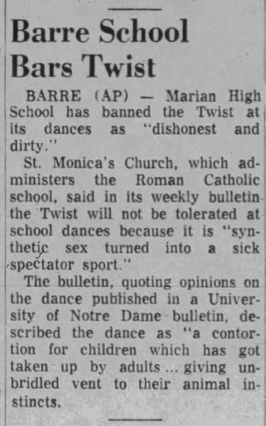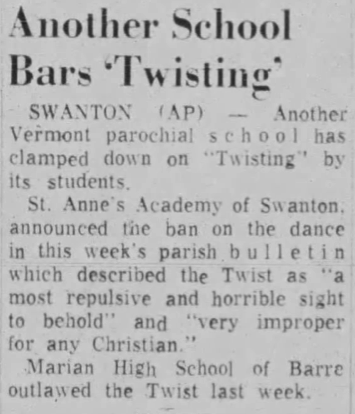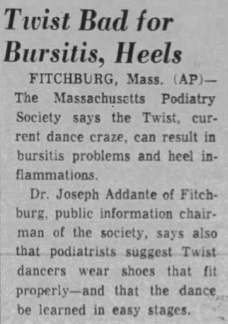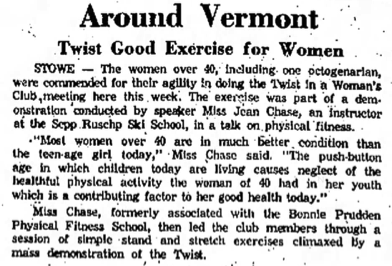Beginning in the summer of 2019, Special Collections worked with the Department of Theatre and Dance to plan an outreach program for this semester that included an exhibit, a lecture, a panel discussion, and a student performance. This is the blog post we planned in conjunction with the April events, now canceled.
In 1962, the dance craze the twist was sweeping the nation. Chubby Checker’s song “The Twist” is credited with starting the trend. It enjoyed two waves of popularity, reaching number one on the Billboard weekly chart in September 1960 and January 1962, when it was re-released. On the annual chart, it peaked at number nine. Other twist classics that enjoyed popular and commercial success that year included Sam Cooke’s “Twistin’ the Night Away” at number 23, “The Peppermint Twist” by Joey Dee and the Starlighters at number 25, and The Isley Brothers classic “Twist and Shout” at number 38.
At UVM, students were twisting at the height of the craze. The Student Association’s Pep Committee sponsored a dance on Saturday, February 17, 1962. Scheduled for 9:30 to midnight, after a men’s basketball game against the University of Massachusetts, it’s not surprising that a handful of star athletes attended. With live music provided by the Craters, a twist-a-thon took place, documented in a set of photographs taken by Andrew Bush. The dance was one of the last events held in the gymnasium (now Royall Tyler Theatre) before Patrick Gym opened in 1963. It must have taken a lot of quick work to transform the gym after the game with crepe paper streamers and dance wax on the floor.
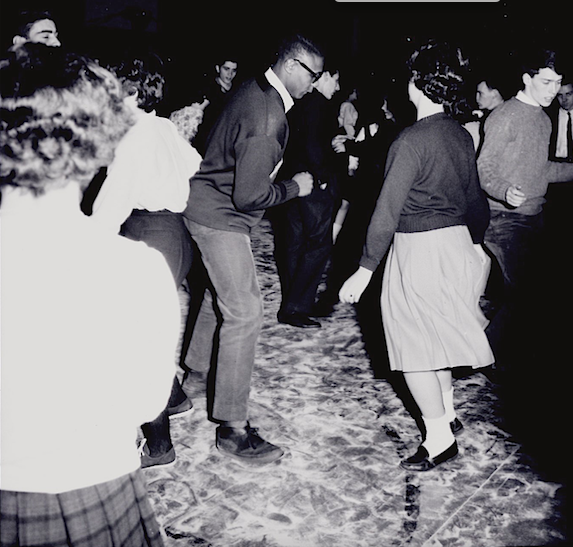
Benny Becton ’63 (center), star basketball player and future UVM Athletic Hall of Fame member, and his dance partner twist in the men’s gym.
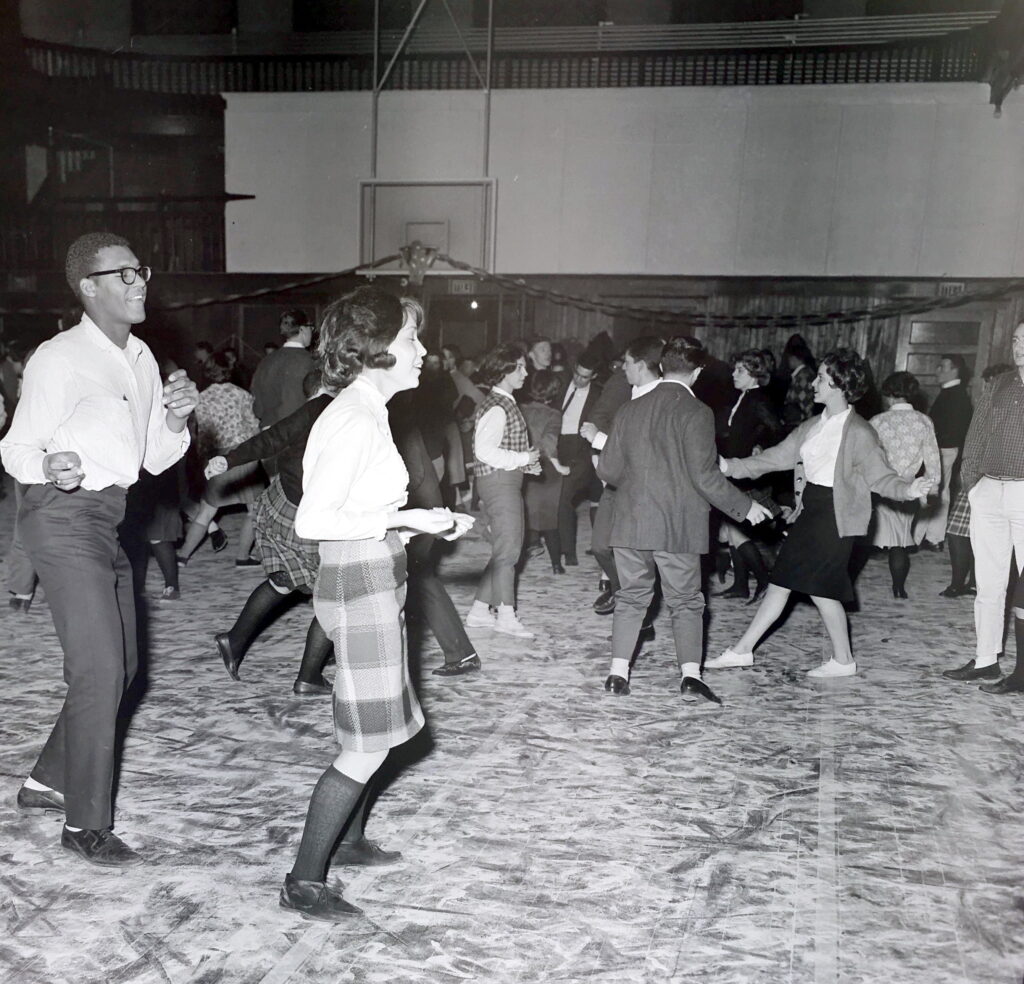
Football star Frank Bolden ‘63 (left) at the 1962 dance. Bolden was inducted into the UVM Athletic Hall of Fame, chaired UVM’s Board of Trustees and received an honorary degree from the university in 2018.
In some ways, the loosened up movements and close contact that characterize the twist mirrored changes in society. Not everyone was a fan.
Famed dancer Ginger Rogers objected to the twist, calling it “ungraceful,” “vulgar,” and “obscene” in this AP story printed in the Burlington Free Press on January 3, 1962.
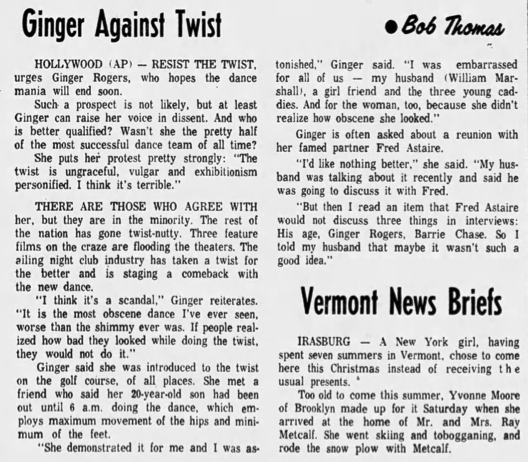 There was a clear generational divide, with youngsters in favor of this newest fad and their parents full of concern (Rutland Daily Herald, January 25, 1962).
There was a clear generational divide, with youngsters in favor of this newest fad and their parents full of concern (Rutland Daily Herald, January 25, 1962).
![A letter to the editor by "High School Student" that concludes "I will stand my ground in regard to this question that all parents ask today [should the twist be censored?]. 'The Twist' is 'OUR DANCE'. We want it, and we don't want everyone condemning it! Let us enjoy 'The Twist' as our parents enjoyed the Charleston."](http://blog.uvm.edu/uvmsc-specialcollections/files/2020/04/Letter_to_Editor_2.png) Still, a few schools in Vermont banned the dance for moral or religious reasons and in quite strong terms. The first was imposed by Marian High School (Brattleboro Reformer, January 23, 1962). St. Anne’s Academy of Swanton took action soon after (Brattleboro Reformer, January 30, 1962).
Still, a few schools in Vermont banned the dance for moral or religious reasons and in quite strong terms. The first was imposed by Marian High School (Brattleboro Reformer, January 23, 1962). St. Anne’s Academy of Swanton took action soon after (Brattleboro Reformer, January 30, 1962).
Twisting brought out warnings for potential back and foot injuries among adults (Brattleboro Reformer, January 24, 1962). But other sources promoted twisting for exercise (Bennington Banner, January 13, 1962).
With these widely varying viewpoints, it’s no wonder the subject of twisting popped up in advice columns (Burlington Free Press, May 19, 1962).
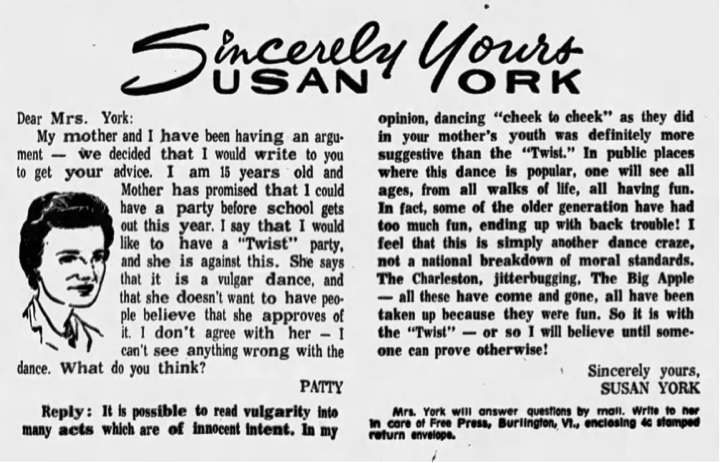 The twist was such a cultural phenomenon that it didn’t take long for twisting to be referenced in the funny papers, like this “Archie” comic that also seems to predict iPods (Burlington Free Press, August 27, 1962).
The twist was such a cultural phenomenon that it didn’t take long for twisting to be referenced in the funny papers, like this “Archie” comic that also seems to predict iPods (Burlington Free Press, August 27, 1962).
Contributed by Erin Doyle, Manuscripts and University Archives Assistant

